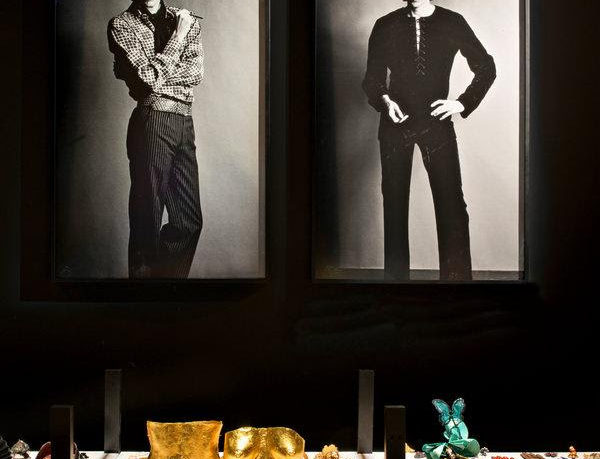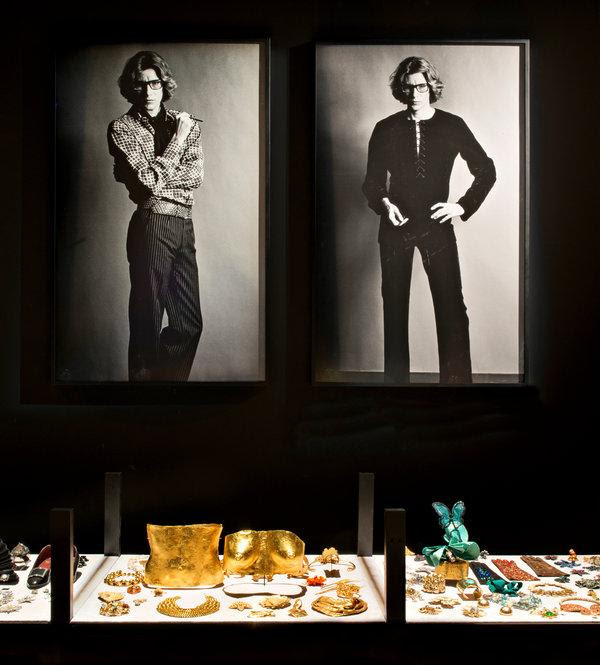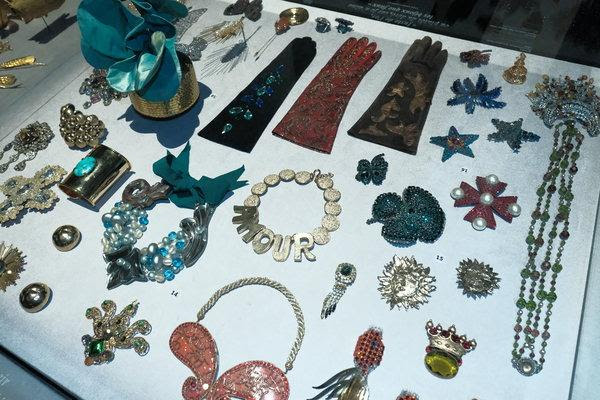New York Times
By Susanne Fowler
Two portraits of Yves Saint Laurent, by Helmut Newton, hang behind a jewelry vitrine in the Yves Saint Laurent Museum in Marrakesh, Morocco.
Credit Nicolas Mathéus/Fondation Jardin Majorelle
Crowds of visitors wait in line to see the clothing displays at the Musée Yves Saint Laurent Marrakesh. But, once inside, they seem equally awed by its Ali Baba’s cave of jewelry.
That cave, as its curator, Dominique Deroche, described it, is a long rectangular vitrine divided into themes — such as color, gold, Africa — that offer another peek into the creative processes of Mr. Saint Laurent, the Algerian-born master designer who died in 2008.
Mr. Saint Laurent’s accessories have been receiving fresh attention since September, when the Musée Yves Saint Laurent Paris opened in his former headquarters on Avenue Marceau; and October, when the museum opened in Marrakesh (the city, he said, that “taught him color”) and Phaidon published “Yves Saint Laurent Accessories” by Patrick Mauriès.
Ms. Deroche had long worked for the fashion house as a press liaison. Now 73, she was part of the team that selected pieces from Mr. Saint Laurent’s vast archive to be displayed in Marrakesh, making what she said were “four or five” visits to Morocco to complete the job.
For the accessories displays alone, she said, there were about 20,000 pieces to consider. She made selections with Pierre Bergé, Mr. Saint Laurent’s former business and personal partner (who died in September), and the exhibition designer, Christophe Martin.
“Everything started in 2015,” Ms. Deroche said during an interview in late February in Paris, surrounded by racks of clothing from the designer’s Rive Gauche label. That was when Mr. Bergé asked for her help.
“It’s the first time I’ve curated, but he knew me very well because I had started working there in 1966 and he knew that I knew a lot” about the Saint Laurent style, she said.
Some of the display pieces, chosen from among 20,000 items in the designer’s archives.
Credit Peter Cain
She knew, for example, that the designer’s taste in jewelry was rarely understated. “He put a lot on each look,” Ms. Deroche said. “Sometimes he would add two or three necklaces at once, or two or three bracelets,” drawing from house creations overseen for decades by Loulou de La Falaise, one of his many muses. He also worked with houses and craftsmen like Roger Scemama, Paul Caillol, Gripoix and Robert Goossens.
“Saint Laurent liked accessories very much, but he always said they had to be fake, big and fake,” Ms. Deroche said. “He didn’t like to play with real diamonds.”
But what about, for example, that set of two gold stars dotted with red stones: Surely those are, at least, garnets?
“Fake, fake, fake,” Ms. Deroche emphasized. “He loved that, you know. But he always worked with the top sculptors and real jewelers. These pieces aren’t glued, they’re encrusted.”
In his jewelry creations, Mr. Saint Laurent also favored forms and materials from nature (brooches shaped like doves or sunflowers) and motifs he considered to be lucky (stars, crosses, hearts and four-leaf clovers). Opulence sometimes would be added, like the gold leaf on an African-influenced wooden bracelet.
Wheat also was a recurring theme in his pins and bracelets. “Straw gives you luck and strength,” Ms. Deroche said. “So even in his private office, we always added a bouquet of wheat.” (It became so closely associated with the designer that Catherine Deneuve, a longtime friend and client, carried a sheaf of wheat to the designer’s funeral.)
Perhaps the most eye-catching items in the Marrakesh vitrine — and among the most valuable, according to Ms. Deroche — are two pieces of wearable gilded bronze by the French sculptor Claude Lalanne, made from casts of the waist and bustline of the model Veruschka in 1969.
They were worn on the runway with breezy chiffon dresses in place of a necklace or a belt.
“Saint Laurent always said that for him, a button or a belt is also a form of jewelry,” Ms. Deroche said.









